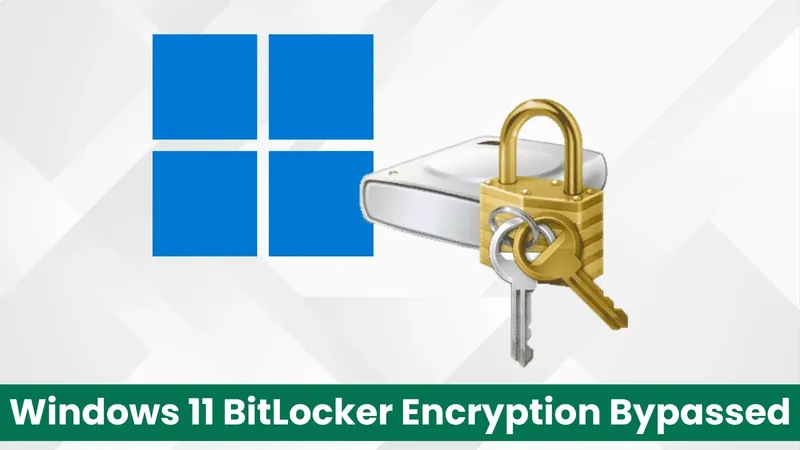
Shocking Discovery: Windows 11 BitLocker Vulnerability Exposed - Your Data at Risk!
2025-01-02
Author: Lok
Shocking Discovery: Windows 11 BitLocker Vulnerability Exposed - Your Data at Risk!
In a startling revelation, researchers have uncovered a serious vulnerability within Windows 11's BitLocker encryption system, allowing potential attackers to extract Full Volume Encryption Keys (FVEKs) directly from a computer's memory. This alarming finding raises significant concerns about the safety of data secured by one of the most recognized encryption tools on the market.
Attack Mechanism
The core of the attack exploits a physical access scenario where an intruder can restart a targeted device and capture its RAM contents. During normal operation, encryption keys are temporarily held in the system’s memory, making it possible to access sensitive information if an attacker can quickly dump this memory before it degrades.
Following a power cut, the quality of RAM contents diminishes rapidly, so any would-be attacker has to act fast. Researchers suggest that sophisticated methods, like cooling the RAM or keeping power running via external sources, could delay degradation and maintain the integrity of the data during an assault.
In one remarkable experiment, the attacker utilized a technique to short-circuit the reset pins on the motherboard, rebooting the system without cutting the power. This clever maneuver allowed them to bypass memory loss and extract crucial data.
The Chilling Bypass of Secure Boot
Even with Secure Boot — aimed at preventing unauthorized software from launching during startup — in place, researchers found that it can be compromised using various exploits such as custom shims. This means attackers could potentially load their own tools for analyzing memory, circumventing another layer of protection designed to keep data safe.
Step-by-Step Breakdown of the Attack
1. **Preparation with a Bootable USB:** An attacker must create a USB device larger than the system's RAM, pre-loaded with specialized software tailored for memory extraction.
2. **Timing the Restart:** The key moment comes when restarting the target system during the Windows loading phase, just before the login screen appears, to snag the encryption keys held in memory.
3. **Booting from the USB:** Next, the attacker boots the system using the USB to enter a custom UEFI shell, deploying tools to carry out the memory dump.
4. **Thorough Memory Analysis:** After dumping the memory contents, tools like `xxd` and `searchMem` are employed to dissect the data, revealing valuable cryptography keys tucked away in specific memory pools.
Key Recovery Process Revealed
The analysis brought to light FVEK keys located within particular Windows kernel memory pool tags tagged as `dFVE`, which connects to BitLocker's crash dump filter module. The presence of key metadata indicating the encryption algorithm used—like XTS-AES-128—was crucial for the attackers.
This sobering vulnerability serves as a crucial reminder that even the most robust encryption systems, like Microsoft's BitLocker, are not impervious to determined physical access attacks. Despite Microsoft’s attempts at mitigating risks through key destruction during shutdowns, remnants of keys can linger in volatile memory.
Recommendations for Safeguarding Your Data
To safeguard your data, experts recommend:
- **Enabling Hardware Security Features:** Always leverage Trusted Platform Module (TPM) to enhance your device’s defense.
- **Implementing Strong Physical Security:** Organizations must adopt comprehensive physical security measures to thwart unauthorized access to devices.
- **Microsoft's Response:** The tech giant is urged to reevaluate and strengthen key management practices to minimize vulnerabilities associated with volatile memory.
As technology evolves, so do the methods of potential threats, highlighting the fact that no security system is infallible, especially when faced with direct physical attacks. Stay informed, stay secure!



 Brasil (PT)
Brasil (PT)
 Canada (EN)
Canada (EN)
 Chile (ES)
Chile (ES)
 Česko (CS)
Česko (CS)
 대한민국 (KO)
대한민국 (KO)
 España (ES)
España (ES)
 France (FR)
France (FR)
 Hong Kong (EN)
Hong Kong (EN)
 Italia (IT)
Italia (IT)
 日本 (JA)
日本 (JA)
 Magyarország (HU)
Magyarország (HU)
 Norge (NO)
Norge (NO)
 Polska (PL)
Polska (PL)
 Schweiz (DE)
Schweiz (DE)
 Singapore (EN)
Singapore (EN)
 Sverige (SV)
Sverige (SV)
 Suomi (FI)
Suomi (FI)
 Türkiye (TR)
Türkiye (TR)
 الإمارات العربية المتحدة (AR)
الإمارات العربية المتحدة (AR)